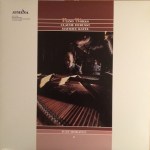I don’t know of another recording of the work that gets the sound of the piano better. On the better copies, the percussive quality of the instrument really comes through.
Without question this is a phenomenal piano recording in every way.
It’s amazing how many piano recordings have poorly-miked pianos. The badly recorded pianos are either too distant, lack proper reproduction of the lower registers, or somehow smear the pounding of the keys into a blurry mess.
Are they badly recorded?
Or is it a mastering issue?
Perhaps a pressing issue?
To be honest, it’s probably all three.
On the best copies the rich texture of the strings is out of this world — you will have a very hard time finding a DG with better string tone. This record does not have the shortcomings of the average DG: it’s not hard, shrill, or sour.
DG made plenty of good records in the 50s and 60s, then proceeded to fall apart, like most labels did. This is one of their finest. It proves conclusively that at one time — 1962 to be exact — they clearly knew exactly what they were doing.
Lately we have been writing quite a bit about how good pianos are for testing your system, room, tweaks, electricity and all the rest, not to mention turntable setup and adjustment.
- We like our pianos to sound natural (however one chooses to define the term)
- We like them to be solidly weighted
- We like them to be free of smear, a quality that is rarely mentioned in the audiophile reviews we read
Other records that we have found to be good for testing and improving your playback can be found here.
Further Reading
 The Music of Tchaikovsky Available Now
The Music of Tchaikovsky Available Now
 More of the music of Modest Mussorgsky (1839-1881)
More of the music of Modest Mussorgsky (1839-1881)
